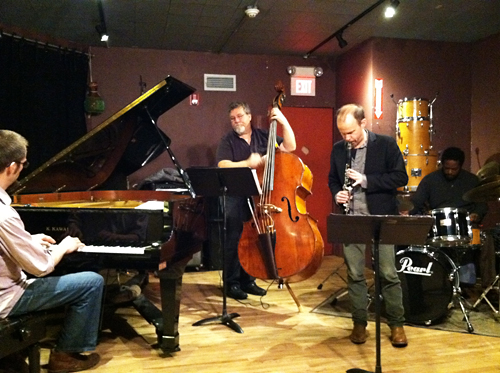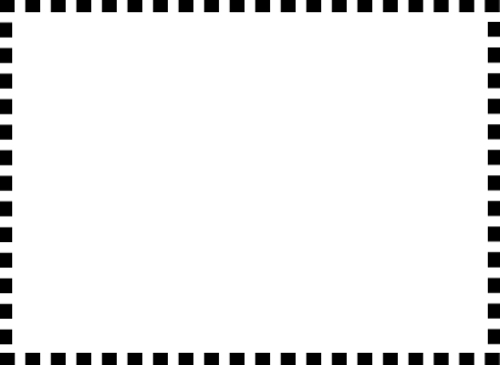Posts Tagged ‘advertising’
A Concert in Cambridge by a Dane Recommended by Swedes
Wednesday, April 27th, 2011We are certainly living in a different world. Why did it take a heads up from friends in Sweden to know about a gig at a venue I frequent? Poor advertising? Certainly. But it’s also a story of how we share information these days. It’s not just friends around the corner, but those in different parts of the globe that often provide us with timely missives about things they know about. As my wife says, we are truly living in a transnational village.
The concert? Jacob Anderskov on piano with the Americans Chris Speed on sax and clarinet, Michael Formanek on bass, and Gerald Cleaver on drums. They played pieces from last year’s Agnostic Revelations, released on the ILK label. Squeezed in between a couple of other performers, they managed about 45 minutes of telepathy and interplay. Anderskov’s somewhat angular, and at times economic, style pointed to his Scandinavian jazz roots though the group clearly has forged their own identity. If you didn’t make the gig—and there weren’t many us there—get the album, and look for his name next time he comes around.
3 Reasons Crowdsourcing a Logo is a Bad Investment
Wednesday, November 17th, 2010Most experienced graphic designers do not participate in open calls for logo designs. There’s a good reason why clients shouldn’t either.
1.You can count on your logo being developed by inexperienced designers. Because this process is seen as an opportunity for young people to build a portfolio, you’ll need to be concerned about potential problems from poorly executed solutions. Incorrectly formatted files that don’t print properly and logos illegible at certain sizes are just a few of the issues you might have to confront. Also, who will tell you that “looking good†doesn’t necessarily mean that it’s a good or appropriate design for your logo?
2. Your logo will be an isolated element, not really part of an integrated corporate identity. Applications of your logo are likely to be no more than a case of pasting it wherever it’s needed—and that’s not an identity. Designers that have a track record depend on more than their sense of design to deliver successful solutions. A familiarity with marketing strategy and the big picture—and asking the right questions—result in a successful and consistent approach that inexperience just doesn’t deliver.
3. The best designers will leave the field after a time because they can’t make a living based on this model. That’s bad for everyone. Our ability to communicate should not be based on the work of amateurs. This process is sometimes defended as a way for young people to get experience, but it’s not sustainable. When one gets paid for his or her thinking through competitions, then the effective hourly rate is pretty low. If this really were the smart use of “group intelligence,†as it has been heralded, then it wouldn’t be a competition, but cooperation instead—and that’s not what clients want to shell out for.
In short, you get what you pay for. If we continue to rely on this approach, after a time it will be hard to find the kind of expertise required to develop an identity that does its job effectively because the professionals will all be doing something else. (By the way, how do you like my writing?)
Signposts #4
Wednesday, August 25th, 2010Space, and Silence
Saturday, June 5th, 2010
Too often we dismiss white space in art and print and silence in music as nothing. The reality is that it is very much something—as much a part of what we understand about the art we encounter as what we might call the substantive part. In fact, the absence of these “nothings†would propose very different readings of pieces before us.
In Josef Alber’s famous book, Interaction of Color, he talks about how colors do not exist in a vacuum. Individual colors are understood in context; that is, what surrounds a color is an important part of how we perceive it.
The same is true in music. Morton Feldman composed many pieces that forced his listeners to consider notes differently than usual because of the space with which he surrounded them. Remove them, and they become entirely different pieces.
Of course, the most famous piece about silence, 4’33” by John Cage, is not really about silence at all. It is about listening.
Besides the reverb which bathes each recording on the German label ECM, every one of their CDs start with 4 or 5 seconds of silence. In this way, the first sounds of the performance are heard differently than if they began instantaneously. That approach has another effect: it separates the music you are about to hear from the world of ordinary sounds. (Think of what we consider to be ordinary sounds these days as compared to 100 years ago!) It is the label’s way of setting the experience apart from normal life, should you choose to really listen. Not unlike what is attempted during the services in sacred buildings.
A print or drawing with a mat around it in a frame is saying the same thing: this is special—pay attention, and you’ll be rewarded. The “white space†of the mat helps to ensure that other elements in the area in which the art is displayed do not become part of the viewer’s experience.
Often I have clients tell me that I have an excellent opportunity to add more information to an ad or brochure because of the white space I have employed—usually used deliberately to make the piece more effective. The irony is that less will be communicated because it would have become more difficult for a viewer to enter and engage with the material. (In many cases, it is a question of the client not having gone through the exercise of deciding what are the most important messages to be delivered and wanting to cover all their bases: a case of too much is not enough.)
I’ve talked about the effect that these “nothings†have on the “substantive†part of things, but what about looking at it the other way around? The spaces and silences are all bordered by their opposite, and so are limited by their borders. Sounds like shapes to me—again, that’s really something!
Long live nothing.




